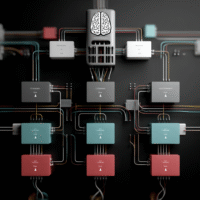Compare
We compare all the best AI products for business
-
Sber GigaChat vs GPT-4: Can Russian-Language AI Match Global Leaders?
Sber GigaChat vs. GPT-4: Can Russian-Language AI Match Global Leaders? This comparison aims to assess whether Sber GigaChat, Russia’s leading large language model (LLM), can compete with OpenAI’s GPT-4 as a business solution. With geopolitical shifts impacting technology access, understanding the capabilities of regional AI offerings like GigaChat is crucial for businesses operating in, or […] ➡️➡️➡️
-
SAP Signavio vs Celonis: Who Offers the Strongest ERP-Native Process Optimization?
Comparing SAP Signavio and Celonis: ERP-Native Process Optimization This comparison aims to determine which of these two prominent players – SAP Signavio and Celonis – offers the stronger solution for businesses seeking to optimize processes specifically within and around their ERP systems. Both are powerful process mining and management tools, but their origins, strengths, and […] ➡️➡️➡️
-
Smol Developer vs Windsurf: Autonomy or Productivity—Which AI Dev Stack Delivers More?
Smol Developer vs. Windsurf: A Head-to-Head Comparison for Businesses Brief Product Descriptions: Smol Developer is an AI-powered platform designed to build entire applications from the ground up. It uses AI for planning, code scaffolding, and file generation, allowing developers to visually manage and edit the application’s architecture. Think of it as an AI co-pilot that […] ➡️➡️➡️
-
Phonexia vs Auraya EVA: Low-Latency or Low-Code—Which Wins the Developer Vote?
Phonexia vs. Auraya EVA: Low-Latency or Low-Code – Which Wins the Developer Vote? This comparison dives into two interesting players in the conversational AI space: Phonexia and Auraya. Both offer solutions for voice-based applications, but they take distinctly different approaches. Phonexia leans heavily into powerful, low-latency performance geared towards developers who need speed and accuracy. […] ➡️➡️➡️
-
Equalture vs Pymetrics: Which Game-Based Hiring Platform Offers Less Bias and More Insight?
Equalture vs. Pymetrics: A Head-to-Head Comparison of Game-Based Hiring Platforms Brief Product Descriptions: Equalture uses neuroscience-backed games designed to assess candidates’ behavioral traits and predict team fit. It emphasizes Diversity, Equity, and Inclusion (DEI) analytics, providing insights into potential biases in the hiring process and suggesting adjustments. Equalture aims to move beyond skills-based assessments to […] ➡️➡️➡️
-
Amazon Translate vs Google Translate: Which Cloud Giant Handles Scale and Speed Better?
Amazon Translate vs. Google Translate: A Business Comparison This comparison aims to evaluate Amazon Translate and Google Translate as potential solutions for businesses needing machine translation services. Both are powerful tools, but cater to slightly different needs and integrate into different ecosystems. We’ll look at ten key criteria to determine which cloud giant handles scale […] ➡️➡️➡️
-
Aiforia vs PathAI: Histology AI Battle—Which One Fits Pharma and Research Better?
Aiforia vs. PathAI: Histology AI Battle – Which One Fits Pharma and Research Better? This comparison aims to dissect Aiforia and PathAI, two leading players in AI-powered pathology, to help pharmaceutical companies and research institutions determine which solution best aligns with their specific needs. Both companies are tackling the challenge of extracting more insights from […] ➡️➡️➡️
-
ABBYY FlexiCapture vs Rossum: Can Traditional OCR Keep Up With Modern Deep Learning?
Comparing ABBYY FlexiCapture vs. Rossum: A Head-to-Head Analysis Purpose of Comparison: This comparison aims to evaluate ABBYY FlexiCapture and Rossum, two leading Intelligent Document Processing (IDP) solutions, across ten key criteria. The goal is to help businesses understand which platform better suits their needs, particularly considering the shift from traditional OCR to modern deep learning […] ➡️➡️➡️
-
Roboflow vs Clarifai: Platform vs Flexibility—What Helps Teams Ship Vision Faster?
Roboflow vs. Clarifai: Platform vs. Flexibility – What Helps Teams Ship Vision Faster? This comparison aims to help businesses decide between Roboflow and Clarifai for their computer vision needs. Both platforms offer powerful tools, but cater to different approaches. Roboflow leans toward a streamlined, user-friendly platform focused on accelerating dataset management and model deployment. Clarifai, […] ➡️➡️➡️
-
H2O.ai vs SageMaker Autopilot: Can Open Core Outperform Big Cloud in Model Performance?
H2O.ai vs. SageMaker Autopilot: Can Open Core Outperform Big Cloud in Model Performance? This comparison aims to evaluate H2O.ai’s Driverless AI and Amazon SageMaker Autopilot, two leading automated machine learning (AutoML) solutions, across ten key criteria relevant to business users. The goal is to determine which platform provides a more robust, effective, and ultimately valuable […] ➡️➡️➡️
-
Lucidworks Fusion vs Sinequa: Which AI Platform Excels at Complex Enterprise Search?
Comparing Lucidworks Fusion and Sinequa: A Framework & Analysis Purpose of Comparison: Both Lucidworks Fusion and Sinequa are powerful AI-powered search platforms designed to unlock insights from complex enterprise data. However, they approach the problem with different strengths. This comparison aims to provide a clear, criterion-based assessment to help businesses determine which platform best suits […] ➡️➡️➡️
-
Whisper (OpenAI) vs AssemblyAI: Open-Source or API-Powered—Which Wins on Flexibility and Accuracy?
Whisper (OpenAI) vs. AssemblyAI: Open-Source or API-Powered—Which Wins on Flexibility and Accuracy? This comparison dives into two strong contenders in the speech-to-text (STT) space: OpenAI’s Whisper and AssemblyAI. Both offer powerful capabilities, but they take fundamentally different approaches. Whisper is an open-source model you can run yourself, while AssemblyAI is a fully managed API service. […] ➡️➡️➡️
-
Google Speech-to-Text vs Amazon Transcribe: Who Handles Real-Time Transcription Better?
Comparing Google Speech-to-Text vs. Amazon Transcribe: Real-Time Transcription Showdown Purpose of Comparison: Businesses increasingly need accurate, real-time transcription for applications like live captioning, contact center analytics, meeting summaries, and more. Both Google Speech-to-Text and Amazon Transcribe are leading contenders in this space. This comparison aims to provide a clear, objective assessment to help businesses choose […] ➡️➡️➡️
-
Sybill vs Symbl.ai: Who Analyzes Sales Conversations Smarter—Emotion or Intent?
Sybill vs. Symbl.ai: Who Analyzes Sales Conversations Smarter—Emotion or Intent? This comparison dives into two leading AI-powered conversation intelligence platforms: Sybill and Symbl.ai. Both aim to help businesses unlock insights from customer interactions, particularly sales calls, but they approach the problem differently. Sybill focuses heavily on how things are said – the emotional cues – […] ➡️➡️➡️
-
UiPath vs Automation Anywhere: Who Leads the Automation Race in 2025?
UiPath vs. Automation Anywhere: Who Leads the Automation Race in 2025? Purpose of Comparison: This comparison aims to evaluate UiPath and Automation Anywhere, two leading Robotic Process Automation (RPA) platforms, across key business-critical criteria to determine which is better positioned to dominate the intelligent automation landscape in 2025. The focus is on their evolution with […] ➡️➡️➡️
-
Celonis vs IBM Process Mining: Who Leads in Enterprise-Scale Process Intelligence With AI?
Celonis vs. IBM Process Mining: A Head-to-Head Comparison Purpose of Comparison: This comparison aims to provide a clear, objective evaluation of Celonis and IBM Process Mining, two leading enterprise-scale process intelligence solutions leveraging AI. We’ll assess them across ten critical criteria to help businesses understand which platform best suits their needs for process discovery, analysis, […] ➡️➡️➡️
-
IBM Maximo APM vs GE Digital APM: Which Predictive Maintenance System Really Prevents Downtime?
Comparing IBM Maximo APM vs. GE Digital APM: A Predictive Maintenance Showdown This comparison aims to help businesses deciding between IBM Maximo Application Performance Management (APM) and GE Digital APM for their predictive maintenance needs. Both are heavyweight contenders in the industrial asset performance space, but they approach the problem with slightly different strengths. We’ll […] ➡️➡️➡️
-
SentiOne vs Qualtrics XM Discover: Who Delivers Faster and More Accurate Voice of Customer Insights?
Comparing SentiOne vs. Qualtrics XM Discover: A Voice of Customer Insights Showdown Purpose of Comparison: Businesses increasingly rely on understanding customer sentiment to drive improvements. Both SentiOne and Qualtrics XM Discover are AI-powered platforms aiming to deliver those insights, but they approach the challenge differently. This comparison aims to determine which platform delivers faster and […] ➡️➡️➡️
-
Recombee vs Retail Rocket: Can a Global SaaS Platform Outperform a Local Market Leader?
Recombee vs. Retail Rocket: A Head-to-Head Comparison Purpose of Comparison: This comparison aims to evaluate Recombee, a global SaaS recommendation engine, against Retail Rocket, a solution heavily focused on the Russian e-commerce market. We’ll assess which platform provides a stronger overall value proposition, considering factors like scalability, feature breadth, and integration capabilities. The question at […] ➡️➡️➡️
-
iProov vs Clearview AI: Privacy-First or Data-First—Which Approach Wins Trust in Biometrics?
iProov vs. Clearview AI: Privacy-First or Data-First—Which Approach Wins Trust in Biometrics? This comparison dives into two very different approaches to biometric authentication: iProov and Clearview AI. Both leverage facial recognition, but their philosophies, target markets, and operational models are worlds apart. The purpose is to evaluate which solution is more likely to build and […] ➡️➡️➡️


















